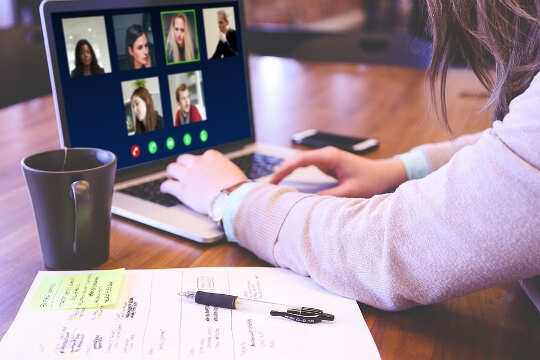
For most women—but not for all women—looking at themselves during virtual meetings has not been accompanied by any changes in how satisfied they are with their appearance, according to new research.
Video chatting services such as Zoom have become a common way to keep in touch with friends, family, and co-workers. But it’s also forced people to sit face-to-face with themselves with a clear view of every pimple, every wrinkle, and every awkward expression they’d otherwise never see.
It’s just weird. But is it worse than that? Have our self-perceptions changed?
First author Gabrielle Pfund, a graduate student in the lab of Patrick Hill, associate professor in the psychological and brain sciences department at Washington University in St. Louis anticipated she might find that people would generally be less satisfied with their appearance the more their video chat usage increased.
As video chatting became more pervasive, “I thought, this is unlike anything I’ve ever experienced. I wonder if this is affecting people?”
She reached out to a former professor, Jennifer Harriger at Pepperdine University, who researches body image and social media. Harriger encouraged Pfund to explore the topic.
For the study, Pfund surveyed 438 women—because, she says, “Women often report more issues with body image than men.” The participants ranged from 18- to 70-year-olds; all but 5% were 55 or younger.
They reported how much time they spent video chatting before the beginning of the pandemic versus after; with whom they shared screens, such as friends, family, co-workers, and/or romantic partners; and answers to a few additional questions about their habits related to video chatting.
Researchers then assessed women on a scale of self-objectification, a measure of a person’s conscious thoughts about how they believe others are perceiving them. They were also assessed on how often they compared their appearance to others.
Finally they were asked how satisfied they were with their own appearance.
Taken together, the women’s responses added up to a picture describing how their video chat usage tracked with how satisfied they were with their appearance, given these tendencies to judge themselves, either against others or through the eyes of others.
“We thought it might be moderated by self-objectification and appearance satisfaction,” she says, meaning the more a woman self-objectified, or the more she compared herself to others, the stronger the negative association would be between time spent video chatting and appearance with one’s satisfaction.
But what about when it came to analyzing the data and seeing how the women’s satisfaction changed in relation to how much more time they’d spent video chatting?
“The main thing we found is, it doesn’t,” she says. “The number of hours you spend video chatting during the day is not associated with how satisfied you are with either your face or your body appearance.”
Mostly.
“For people who scored higher on self-objectification there was a small negative association with appearance satisfaction the more time they spent video chatting,” she says.
It was a small association, but with potentially big consequences for some populations. One reason is because it’s not only friends, families, and coworkers who people have been connecting with via video chat. During the pandemic, many people have also turned to telehealth solutions for medical care.
“Future research should consider whether the use of such platforms may be problematic for some individuals,” Pfund wrote in the paper. Particularly, she says, this preliminary research raises questions about the use of video chatting for treatment for people with certain conditions, such as eating disorders.
And she’s not assuming video chatting use could possibly affect only women. Up next, Pfund plans to look at men’s video chat behaviors: Are the associations the same as with women? Are men comparing their video chat appearances at all?
In the future, she plans to dive deeper into women’s perspectives by having them keep daily records of their video interactions and feelings.
“Then we could tease apart, on days when a person spends more time video chatting, is their appearance satisfaction better or worse,” Pfund says. “Or what about when they spend time chatting with family versus friends versus work?”
Even the same study might look different if she did it again today.
When she started the research, it was May. At the time, it may have seemed like forever, but by now we can say that back then, the video chatting phenomenon was still pretty new—just two months into working from home. Now people are used to it and likely have adjusted to staring at ourselves, sometimes for hours a day.
“It has been almost 10 months of us doing this all the time,” Pfund says. “What it means to us now might be very different than what it meant to us then.”
About the Authors
First author Gabrielle Pfund, a graduate student in the lab of Patrick Hill, associate professor in the psychological and brain sciences department at Washington University in St. Louis.
Jennifer Harriger at Pepperdine University, who researches body image and social media.

Books Improving Attitude and Behavior from Amazon's Best Sellers list
"Atomic Habits: An Easy & Proven Way to Build Good Habits & Break Bad Ones"
by James Clear
In this book, James Clear presents a comprehensive guide to building good habits and breaking bad ones. The book includes practical advice and strategies for creating lasting behavior change, based on the latest research in psychology and neuroscience.
Click for more info or to order
"Unf*ck Your Brain: Using Science to Get Over Anxiety, Depression, Anger, Freak-Outs, and Triggers"
by Faith G. Harper, PhD, LPC-S, ACS, ACN
In this book, Dr. Faith Harper offers a guide to understanding and managing common emotional and behavioral issues, including anxiety, depression, and anger. The book includes information on the science behind these issues, as well as practical advice and exercises for coping and healing.
Click for more info or to order
"The Power of Habit: Why We Do What We Do in Life and Business"
by Charles Duhigg
In this book, Charles Duhigg explores the science of habit formation and how habits impact our lives, both personally and professionally. The book includes stories of individuals and organizations who have successfully changed their habits, as well as practical advice for creating lasting behavior change.
Click for more info or to order
"Tiny Habits: The Small Changes That Change Everything"
by BJ Fogg
In this book, BJ Fogg presents a guide to creating lasting behavior change through small, incremental habits. The book includes practical advice and strategies for identifying and implementing tiny habits that can lead to big changes over time.
Click for more info or to order
"The 5 AM Club: Own Your Morning, Elevate Your Life"
by Robin Sharma
In this book, Robin Sharma presents a guide to maximizing your productivity and potential by starting your day early. The book includes practical advice and strategies for creating a morning routine that supports your goals and values, as well as inspiring stories of individuals who have transformed their lives through early rising.



























